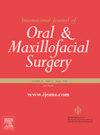胫骨近端骺端自体骨移植术后负重是否安全?系统回顾和荟萃分析。
IF 2.2
3区 医学
Q2 DENTISTRY, ORAL SURGERY & MEDICINE
International journal of oral and maxillofacial surgery
Pub Date : 2024-11-19
DOI:10.1016/j.ijom.2024.10.014
引用次数: 0
摘要
对评估术后抗压强度下降的证据进行了审查。研究遵循了 PRISMA 指南。检索了 PubMed、Embase、Web of Science、Google Scholar 和 ProQuest。五项尸体研究符合纳入标准(49 具尸体)。三项研究报告了导致骨折的力量(FLF),其范围在 1034 牛顿和 9962 牛顿之间,始终高于尸体体重的三倍。只有一项研究报告称,与对侧胫骨相比,去骨瓣胫骨的 FLF 在统计学上明显较低(平均 3766.9 牛顿对 5126.4 牛顿;稳定性降低 26.5%)。虽然所有研究和汇总数据中的平均 FLF 值都高于普通成年人体重三倍的力量(70 千克 x 3 = 2100 牛顿),但有三具尸体的 FLF 值低于这一临界值。将临界值提高到 2400 牛顿(大致相当于 80 千克的体重)后,这一数字增加到 6 个。从统计学角度看,解椎体后正常负重似乎是安全的。但在临床上,作者无法推广这一假设。本文章由计算机程序翻译,如有差异,请以英文原文为准。
Is weight-bearing as tolerated safe after proximal tibial metaphyseal autogenous bone harvest? A systematic review and meta-analysis
Evidence was reviewed to assess the decrease in compressive strength postoperatively. The PRISMA guidelines were followed. PubMed, Embase, Web of Science, Google Scholar, and ProQuest were searched. Five cadaver studies met the inclusion criteria (49 cadavers). Three reported force leading to fracture (FLF), which ranged between 1034 N and 9962 N consistently higher than three times cadaver body weight. Only one reported statistically significant lower FLF in decancellated tibias compared to the contralateral tibias (mean 3766.9 N vs 5126.4; stability reduction 26.5%). The overall estimate of FLF in decancellated tibias was 4321.6 N (95% confidence interval 3434.4-5208.8 N. Meta-analysis estimated a significant difference in force leading to fracture (ΔFLF) 1098.1 N, 95% confidence interval 547.8-1648.5 N. While mean FLF in all studies and the pooled data was above a force three times the body weight of an average adult (70 kg x 3 = 2100 N), three cadavers showed FLF values below this threshold. Increasing the threshold to 2400 N (roughly relating to a body weight of 80 kg, increased this number to six. Normal weight-bearing after decancellation seems to be statistically safe. Clinically, however, the authors are not able to generalize this assumption.
求助全文
通过发布文献求助,成功后即可免费获取论文全文。
去求助
来源期刊
CiteScore
5.10
自引率
4.20%
发文量
318
审稿时长
78 days
期刊介绍:
The International Journal of Oral & Maxillofacial Surgery is one of the leading journals in oral and maxillofacial surgery in the world. The Journal publishes papers of the highest scientific merit and widest possible scope on work in oral and maxillofacial surgery and supporting specialties.
The Journal is divided into sections, ensuring every aspect of oral and maxillofacial surgery is covered fully through a range of invited review articles, leading clinical and research articles, technical notes, abstracts, case reports and others. The sections include:
• Congenital and craniofacial deformities
• Orthognathic Surgery/Aesthetic facial surgery
• Trauma
• TMJ disorders
• Head and neck oncology
• Reconstructive surgery
• Implantology/Dentoalveolar surgery
• Clinical Pathology
• Oral Medicine
• Research and emerging technologies.

 求助内容:
求助内容: 应助结果提醒方式:
应助结果提醒方式:


